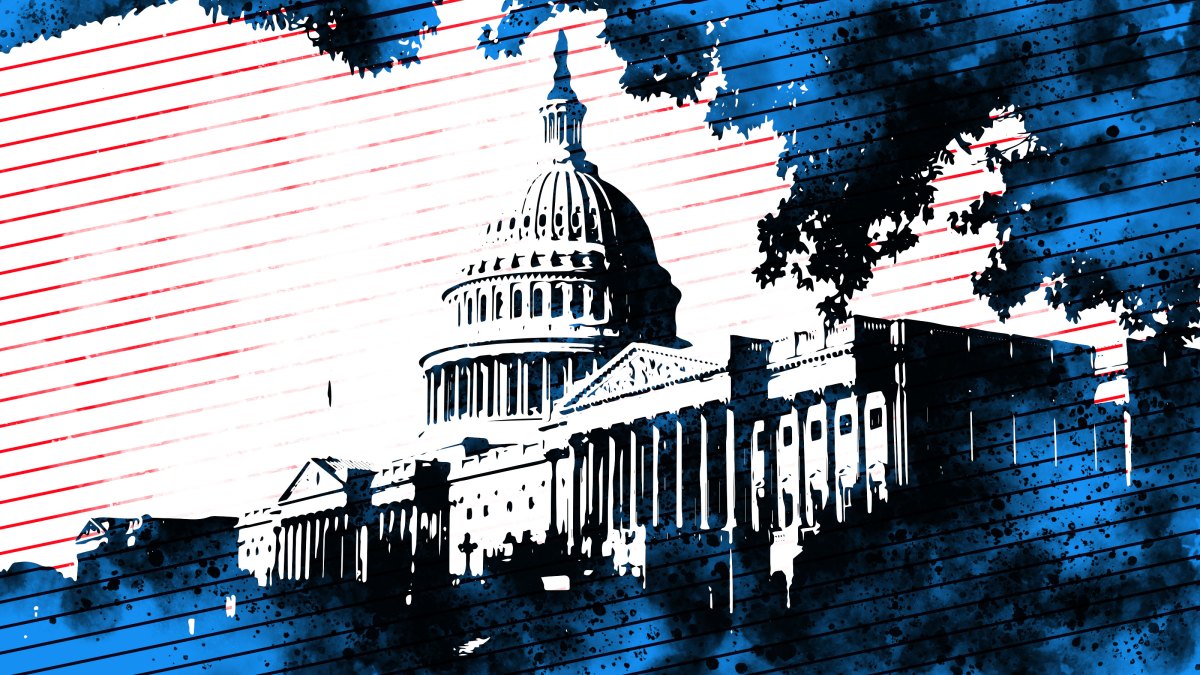The law barring Trump from pulling out of NATO is ‘not airtight,’ expert says
The guardrail against the next president leaving the alliance is shakier than you think.
In the wake of NATO-skeptic President-elect Donald Trump’s victory, backers of the alliance are taking comfort in a year-old U.S. law that says he can’t withdraw unless Congress approves.
But Trump may have a way around it — and it’s a method he has used before.
In 2023, Sens. Tim Kaine (D-Va.) and Marco Rubio (R-Fla.) authored legislation requiring that any presidential decision to exit NATO must have either two-thirds Senate approval or be authorized through an act of Congress. Lawmakers passed the measure as part of the fiscal 2024 National Defense Authorization Act, which President Joe Biden signed into law.
Legal experts warn that Trump could try to sidestep Congress’s NATO guardrail, citing presidential authority over foreign policy — an approach he used before to bypass congressional restrictions on treaty withdrawal.
The law is “not airtight,” said Scott Anderson, a Brookings Institution scholar and senior editor of Lawfare who has argued for firmer restrictions on a president leaving NATO. What it does do, he said, is set up a direct constitutional conflict with Congress if a president does try to withdraw.
“This is not open and shut, this is about Congress telling you you can’t do this, and if you ignore Congress, you’re going to have to fight us in the courts over it,” Anderson said.
If Trump simply declared he was pulling out of the alliance, it’s unclear whether Congress would have the legal standing to sue him for ignoring the law, according to Curtis Bradley, the Allen M. Singer distinguished service professor at the University of Chicago Law School.
The Supreme Court has generally held that institutional conflicts between the branches are political questions best resolved through the political process rather than through judicial intervention.
“For the issue to be litigated, there would need to be someone with standing to sue,” Bradley said in an email. “The only party I can think of who might have standing would be Congress itself, but it is not clear that the Republicans in Congress (who will at least control the Senate) would support such a suit.”
Anderson said lawmakers should strengthen the law by adding language explicitly authorizing litigation, which would improve Congress’ chances of establishing standing in court.
He also explains that while Congress has the strongest standing to sue over a presidential withdrawal from NATO, service members or private individuals — such as Americans who own property in NATO countries — may have potential arguments, but those are less certain. Another possibility, he said, is that one of the chambers could try to sue, if both don’t agree.
Even if the Supreme Court took up the case, it’s not clear who would win because the constitutional question is murky. Congress has never mounted a direct legal challenge to a president withdrawing from a treaty.
“It’s very contested legal terrain, and it’s not 100 percent clear,” Anderson said.
That doesn’t mean a withdrawal, if Trump were able to pursue one, would happen quickly. Under the NATO treaty, a member state would have to submit a “notice of denunciation” to inform the other members of the decision. The country’s membership wouldn’t officially end until after a one-year waiting period.
Meanwhile, Trump could undermine NATO without formally leaving. Democratic lawmakers have warned that he could refuse U.S. support by withholding ambassadors or keeping troops from participating in military exercises. While several lawmakers in February called for new legislative measures to guard against these risks, nothing serious has materialized since.
“Following Trump’s threats in his first term, the Congress — recognizing the vital importance of NATO — acted on a bipartisan basis to prevent any future presidents from unilaterally withdrawing,” Sen. Chris Van Hollen (D-Md.), a member of the Senate Foreign Relations Committee, said in a statement. “While Trump may resort to his old tricks, we’ll continue working to shore up NATO and stand ready to fight back against any attempts to undermine the strength of this alliance.”
Asked to comment, Trump spokesperson Karoline Leavitt said in a statement, “The American people re-elected President Trump because they trust him to lead our country and restore peace through strength around the world.”
It wouldn’t be the first time Trump’s team ignored legal requirements on treaty withdrawal.
In 2019, amid a debate over the Open Skies Treaty, Congress included a provision in the fiscal 2020 National Defense Authorization Act requiring the defense secretary and secretary of state to notify Congress at least 120 days before withdrawing. The 34-nation pact allowed reciprocal surveillance flights between members to monitor military forces and weaponry.
Arms control advocates and internationalists in Congress supported the Open Skies Treaty because, with Russia and countries such as the U.S., the U.K. and France as parties, it promoted transparency and trust. But the Trump administration and some congressional Republicans argued Russia was violating it and that satellite imaging technology made the flights obsolete.
In May 2020, the Trump administration announced its intention to leave the Open Skies Treaty and ignored the legal notification requirements. The Justice Department’s Office of Legal Counsel, at the time led by Assistant Attorney General Steven Engel, issued an opinion arguing that the notice requirements infringed on the president’s constitutional authority over foreign affairs.
“The President’s power to withdraw from treaties flows from his constitutional role as the ‘sole organ of the nation in its external relations,’ granting him discretion in conducting foreign affairs and implementing or terminating treaties without congressional constraints on diplomatic decisions,” Engel wrote in the administration’s final days.
Asked about congressional guardrails on a president leaving NATO, Bradley said the Trump administration’s argument in 2020 that Congress has no regulatory authority isn’t necessarily on solid footing because Congress has a history of regulating treaties.
“I think there should be a heavy burden on presidents to show that a statute is unconstitutional before acting to disregard it, given that our checks and balances depend on presidents having to follow the law, and I don’t think that burden has been met here,” he said.
A NATO spokesperson did not reply to a request for comment.
Because NATO runs on the confidence of allies, former alliance officials said that signaling an exit is as good as leaving. “De facto the day you send the letter it is in a way effective immediately,” said Camille Grande, a former NATO assistant secretary general and now a distinguished policy fellow at the European Council on Foreign Relations. “Because what you’re saying is ‘I’m no longer committed.’”
Beyond the legal aspects of withdrawing, the United States would have to figure out what to do with more than 100,000 U.S. troops stationed in Europe — a number that has grown by one-fifth since Russia’s full-scale invasion of Ukraine more than two years ago. The Defense Department might also have to pull out of NATO’s military command structure, which has been run by an American general dating back to its establishment under then-Gen. Dwight Eisenhower in 1949.
“We are not sort of having a discussion in very quiet times where there is a guy in the White House who’s not a strong believer in alliances and in old-fashioned NATO,” Grande said. “We have a war in Europe. We have a serious concern for many Europeans that the confrontation with Russia might escalate in some shape or form, and then where are we?”
Trump repeatedly criticized NATO allies during his first term for not meeting defense spending targets, openly suggesting reduced U.S. support and even hinting at withdrawal. At a rally this year, he recalled telling allies, “If we don’t pay, are you still going to protect us? … Absolutely not.”
Trump hasn’t said publicly that he would pull out of NATO, but reportedly has discussed it repeatedly in private. He did say on the campaign trail that he would “encourage” Russia “to do whatever the hell they want” to NATO allies who don’t spend enough on defense.
Trump told European Commission President Ursula von der Leyen in 2020 that the U.S. wouldn’t come to Europe’s defense if it was attacked, POLITICO reported. He has said NATO countries subsequently spent “billions and billions” of dollars on their defenses in the wake of his threat.
While critics argue the strong rhetoric is undermining the alliance, some Republicans view it as effective pressure that prompted NATO members to increase military funding.
Both Trump and pro-NATO advocates stress the need for allies to meet defense spending targets, but Trump has at times framed it as a condition for U.S. support. Those allies appear to be relying on the law to bar Trump from taking extreme measures.
“Congress passed legislation according to which you cannot leave NATO without the consent of Congress,” former NATO Secretary General Anders Fogh Rasmussen said in an interview on Wednesday. “And during my visit to U.S. Congress, I have seen a very strong bipartisan support for NATO, staying in NATO. Obviously, a U.S. president can, as a commander in chief, make life difficult for NATO, but to see the U.S. leave NATO? No.”
What's Your Reaction?


















































